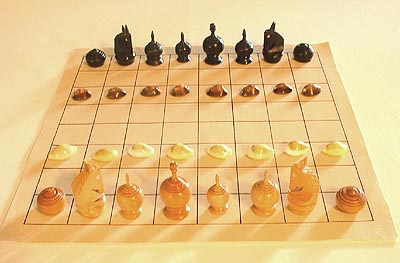How to Play Makruk
The Chess of Thailand and Cambodia
Download
a free rule booklet ------
Shop
for a playing set
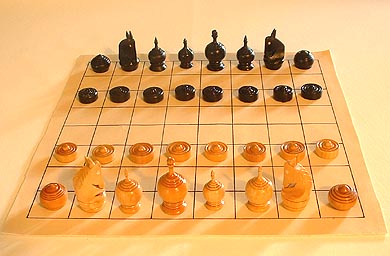
Makruk is still played avidly throughout Thailand and in Cambodia (where it is known as "Ok"), although the familiar western chess is also becoming popular in those areas. Each year in Thailand, a national makruk tournament is held, and the play level in competition is very high. Arrangement The pieces are set up, as shown above, much as they are in our modern western chess. Notice that the pawns are set on the third row, and that the queen (small piece) always begins to the right of its king (large piece). The Pieces and Their Moves Here
are the pieces, their Thai names, and the moves they make on
the board: |
King — “Khun” — Lord Moves exactly the same as the king in western chess: one space in any direction. He does not have the power to castle. |
 |
Queen — “Met” — Seed Moves only one space diagonally. This is the move of the piece in the queen’s place, found in most ancient forms of chess. |
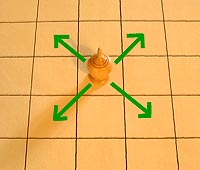 |
| Bishop
— “Khon” — Nobleman Moves one space diagonally or one space forward. This move is found in Japanese chess, and in other chess variants of Southeast Asia. |
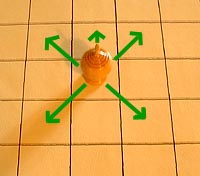 |
| Knight
— “Ma” — Horse Moves two spaces forward, backward, right or left, plus one space at a right angle. This is the only piece allowed to jump over any intervening piece in its path. It has exactly the same move as the knight in western chess. |
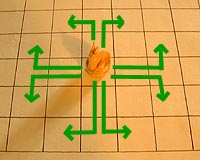 |
| Rook
— “Rua” — Boat Moves as many spaces as desired forward, backward, right or left. Can not leap over any pieces. This move is exactly the same as that of the western rook. |
 |
| Pawn
— “Bia” — Cowry Shell When moving normally, this piece moves one step forward; but it captures by moving one step forward-diagonally. Exactly like the western pawn, but with no power to move two spaces on its first move. |
 |
Promoted Pawn — “Biagai” — (Promoted Cowry) When the pawn reaches the 6th row (i.e., the opponent’s 3rd row), it is flipped over and its move is changed to the move of the queen (met): one space in any diagonal direction. |
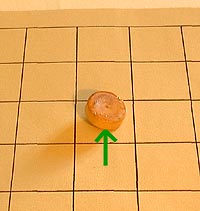 |

Did you notice that the king, queen and bishop are essentially the same shape, but different in size? Even the rook is similar, but a more squat figure. It may be confusing at first, but you will get used to distinguishing them. Captures All pieces capture by moving onto the square of an enemy piece and removing that piece from the board. Only the pawn has a special move for capturing; all others use their normal moves to capture. Check and Checkmate When a player’s king is threatened with capture (in check), he must move in such a way that the king is no longer threatened. If he can not, he is in checkmate, and the game is lost. If, however, the player finds that any move he makes will put his king in check, but he in not in check at the moment, this is a stalemate, and the game is a draw. Drawn Games Many games of makruk end in draws, and this is because of special rules in the endgame which permit the disadvantaged player to claim a draw in very peculiar, and sometimes rather complex, ways. The back panel of this brochure explains the special drawn game rules. Special Drawn Game Rules When you find yourself with a less powerful group of pieces than your opponent, there are two special rules which may draw the game: I. The Board’s Honor Rule If there are no unpromoted pawns on the board, and you are at a distinct disadvantage, you may begin counting your moves aloud up to 64 (the number of squares on the board). If you are able to make the 65th move and you haven’t been checkmated, the game is a draw. II. The Pieces’ Honor Rule Watch for the situation in which (1) you have a lone king with no remaining pieces and, at the same time (2) there are no unpromoted pawns on the board. At that moment (when your last piece is taken, or your opponent’s last pawn is promoted), you must stop and do some figuring. Follow this system carefully, and you may be able to claim a draw. 1.
Find the move count number in this way. First ask, 2. Now that you have the move count number, count all of the pieces on the board, including all of your opponents pieces, his king and your king. For instance if he has 1 rook, 2 bishops, 2 promoted pawns and a king, against your lone king, you count up to 7. (In this example the move count number is 16.) 3. Now, as you make your move (finally, after all that calculating), begin counting from where you left off. In the example above, your move will be counted “8.” You continue to count all of your own moves (in this example, ...9, 10, 11…) up to the move count number (in this example ...16). If you reach the move count number without being checkmated, your opponent has one final move to deliver checkmate. If he can not — congratulations — you’ve drawn the game!
The older traditional Thai chess sets used cowry shells as pawns, which come naturally in lighter and darker varieties. When they promoted, they were flipped over to show their openings. |
Download a free rule booklet ------ Shop for a playing set
HOME
PAGE CHESS PRODUCTS: International | Asian | Reproductions | Unique | Rare | Other Games CHESS HISTORY PAGES: 1 | 2 | 3 | 4 | 5 | 6 | 7 | 8 | 9 | 10 HOW TO PLAY: Chess | Courier Chess | Sittuyin | Xiangqi | Shogi | Shatranj | Janggi Makruk | Shatar | Dou Shou Qi | Luzhanqi LINKS: Chess Variants | Chess History | Chess Articles | Mah Jongg AFFILIATED SITES: Rick Knowlton | Courier Chess | Knowlton Mosaics Ken Knowlton | Insite Age | VerySpecial.us CONTACT US |
